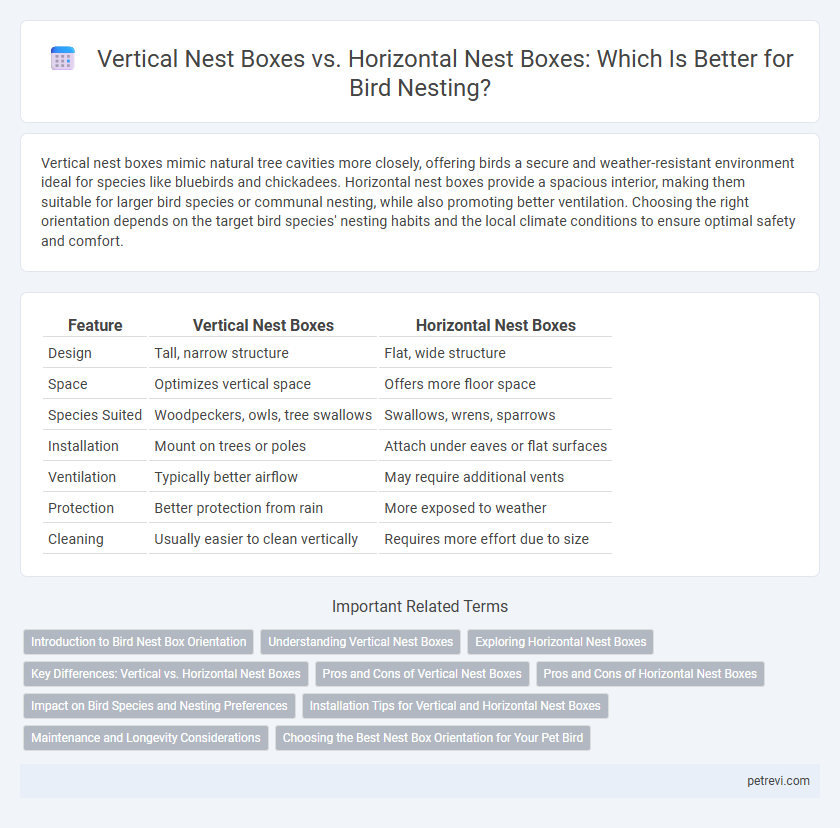Vertical nest boxes mimic natural tree cavities more closely, offering birds a secure and weather-resistant environment ideal for species like bluebirds and chickadees. Horizontal nest boxes provide a spacious interior, making them suitable for larger bird species or communal nesting, while also promoting better ventilation. Choosing the right orientation depends on the target bird species' nesting habits and the local climate conditions to ensure optimal safety and comfort.
Table of Comparison
| Feature | Vertical Nest Boxes | Horizontal Nest Boxes |
|---|---|---|
| Design | Tall, narrow structure | Flat, wide structure |
| Space | Optimizes vertical space | Offers more floor space |
| Species Suited | Woodpeckers, owls, tree swallows | Swallows, wrens, sparrows |
| Installation | Mount on trees or poles | Attach under eaves or flat surfaces |
| Ventilation | Typically better airflow | May require additional vents |
| Protection | Better protection from rain | More exposed to weather |
| Cleaning | Usually easier to clean vertically | Requires more effort due to size |
Introduction to Bird Nest Box Orientation
Birds exhibit preferences for nest box orientation based on species-specific behaviors and environmental conditions, making vertical and horizontal designs critical factors in successful nesting. Vertical nest boxes often mimic tree cavities or natural crevices favored by species like bluebirds and chickadees, while horizontal nest boxes align with ground-nesting birds that require floor access and concealment. Proper orientation optimizes microclimate control, predator protection, and accessibility, enhancing reproductive success in avian populations.
Understanding Vertical Nest Boxes
Vertical nest boxes provide an ideal environment for cavity-nesting birds such as bluebirds and chickadees, mimicking natural tree holes with their tall, narrow structure. These boxes enhance protection from predators and weather by limiting access points and improving water drainage through their upright design. Proper placement of vertical nest boxes at recommended heights and orientations significantly increases breeding success and bird occupancy rates.
Exploring Horizontal Nest Boxes
Horizontal nest boxes provide birds with greater interior space and improved ventilation compared to vertical designs, enhancing comfort and occupancy rates. Species such as bluebirds, wrens, and chickadees show a strong preference for horizontal boxes due to their wider entrance and roomy interior. Optimal placement on tree trunks or horizontal branches mimics natural cavities, supporting successful breeding and fledging.
Key Differences: Vertical vs. Horizontal Nest Boxes
Vertical nest boxes are designed with a taller and narrower profile, offering birds like bluebirds and chickadees ample vertical space, which helps deter predators by limiting access. Horizontal nest boxes provide a wider, shallower interior favored by species such as wrens and swallows, facilitating more natural nesting behavior and easier entrance for these birds. The choice between vertical and horizontal designs impacts ventilation, predator protection, and species suitability, optimizing nesting success based on bird habits and habitat needs.
Pros and Cons of Vertical Nest Boxes
Vertical nest boxes offer efficient use of space, making them ideal for small gardens or areas with limited room for bird habitats. Their design typically provides better protection against predators and harsh weather, enhancing chick survival rates. However, vertical boxes may limit species preference, as some birds favor horizontal layouts for easier access and nest-building comfort.
Pros and Cons of Horizontal Nest Boxes
Horizontal nest boxes provide more space and easier access for larger bird species, promoting better ventilation and reducing the risk of overheating. However, they may be more vulnerable to predators and weather conditions due to their broader entrance. Their design suits cavity-nesting birds that prefer wide openings, but security and insulation concerns require careful placement to enhance nesting success.
Impact on Bird Species and Nesting Preferences
Vertical nest boxes cater to cavity-nesting birds like chickadees and nuthatches by mimicking natural tree holes, promoting species such as bluebirds and titmice to establish secure nests. Horizontal nest boxes, often designed as platform or open-style structures, attract a wider range of species including swallows and wrens by providing easy access and ample space for larger broods. Bird species exhibit distinct nesting preferences influenced by box orientation, with vertical designs favoring shelter and protection while horizontal boxes support species requiring open visibility and room for communal nesting.
Installation Tips for Vertical and Horizontal Nest Boxes
Vertical nest boxes require secure mounting at a height of 6 to 12 feet on sturdy poles or tree trunks to protect birds from predators and harsh weather. Horizontal nest boxes should be placed in shaded areas with entrance holes facing away from prevailing winds, ideally positioned 4 to 8 feet above the ground to accommodate species preferring lower nesting sites. Both types benefit from stable installation using brackets or straps to minimize movement and ensure long-term safety for nesting birds.
Maintenance and Longevity Considerations
Vertical nest boxes typically offer better drainage and airflow, reducing moisture buildup that can lead to wood rot and prolonged maintenance intervals. In contrast, horizontal nest boxes may retain more debris and water, requiring more frequent cleaning to prevent mold and decay, thus impacting their longevity. Selecting rot-resistant materials enhances durability for both types, but vertical designs generally promote longer service life with lower upkeep efforts.
Choosing the Best Nest Box Orientation for Your Pet Bird
Vertical nest boxes provide a more natural, tree-like environment that supports climbing and perching behaviors essential for many pet bird species, promoting healthier activity levels. Horizontal nest boxes offer increased floor space, making them ideal for ground-dwelling or burrowing birds that require ample room for nesting materials and movement. Selecting the best nest box orientation depends on the specific bird species' natural habits, ensuring optimal comfort and breeding success.
Vertical nest boxes vs Horizontal nest boxes for Bird nesting Infographic

 petrevi.com
petrevi.com